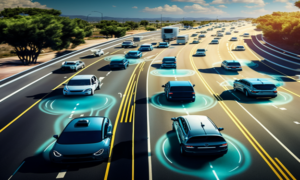The Future of Autonomous Vehicles
Discover the transformative potential of autonomous vehicles in our comprehensive overview. From advanced technologies like machine learning and computer vision to the societal impacts and challenges of widespread adoption, we explore how self-driving cars are reshaping transportation. Learn about the evolution of AV technology, predictions for future urban planning, and the necessary regulatory frameworks. Delve into how this innovation will change our relationship with mobility and what it means for safety, job markets, and the environment in the coming decades.
The Future of Autonomous Vehicles: What to Expect
Introduction to Autonomous Vehicles
Autonomous vehicles, commonly referred to as self-driving cars, represent a paradigm shift in the automotive industry, leveraging advanced technology to operate without human intervention. The fundamental concept of these vehicles is to utilize an array of sensors, powerful software, and artificial intelligence to safely navigate roads, respond to dynamic environments, and ensure passenger safety. This integration of technology allows autonomous vehicles to perform tasks such as lane changing, obstacle avoidance, and traffic navigation with minimal or no human oversight.
The development of autonomous vehicles is a culmination of decades of innovation in computing, machinery, and engineering. From the introduction of the first automated pilot systems in aviation to the research and trials conducted by various automotive manufacturers and tech companies, the evolution from traditional vehicles to autonomous machinery embodies a significant technological transition. Early milestones include the establishment of rudimentary cruise control systems and parking assistance technologies, which laid the groundwork for more sophisticated autonomous mechanisms.
Currently, autonomous vehicle technology is at various stages of development across the globe. Many manufacturers are conducting extensive road tests and pilot programs to refine the safety and reliability of their self-driving models. Companies such as Tesla, Waymo, and Uber have made substantial advancements, harnessing machine learning and data analytics to improve real-time decision-making processes. Although fully autonomous vehicles—classified as Level 5 automation—remain largely in the experimental phase, advancements in semi-autonomous features are becoming more prevalent in modern vehicles today. Collectively, this progression highlights a burgeoning industry that promises to reshape transportation as we know it.
Technological Advances Driving the Future
The evolution of autonomous vehicles is significantly influenced by a range of technological advancements, which are enhancing their safety and reliability. At the forefront of this revolution is machine learning, a subset of artificial intelligence that enables vehicles to learn from data and improve their decision-making capabilities over time. By analyzing patterns from vast datasets generated by previous driving experiences, machine learning algorithms can better predict potential hazards and react accordingly, making self-driving cars more adept at navigating complex environments.
Complementing machine learning, computer vision plays a crucial role in the functionality of autonomous vehicles. This technology allows cars to interpret and process visual information from their surroundings, such as identifying pedestrians, recognizing traffic signs, and understanding road conditions. Utilizing high-resolution cameras and advanced image processing techniques, computer vision systems operate in real-time, enabling cars to make split-second decisions essential for avoiding accidents and ensuring passenger safety.
Real-time data processing further enhances the reliability of self-driving vehicles. By constantly analyzing data from various sensors and navigation systems, such as LiDAR and GPS, autonomous cars can maintain accurate awareness of their environment. This capability is paramount for adjusting to dynamic traffic conditions and responding effectively to unforeseen challenges on the road.
Moreover, the integration of 5G connectivity and the Internet of Things (IoT) is set to revolutionize the autonomous driving experience. With high-speed wireless communication, vehicles can exchange information with each other and infrastructure in real-time, leading to improved traffic management and reduced congestion. The synergy between these technologies supports the development of modern infinity automobiles capable of optimizing routes, enhancing fuel efficiency, and minimizing accidents. As these technological advancements converge, they shape a future where autonomous vehicles operate seamlessly, offering a safer and more efficient transportation solution.
Societal Impacts and Regulatory Challenges
The widespread adoption of autonomous vehicles (AVs) is anticipated to have significant societal implications, influencing various aspects of daily life and reshaping urban landscapes. One of the most pressing concerns relates to job displacement in driving-related industries. The transition towards fully automated transport could result in substantial job losses for professional drivers, including those employed in trucking, public transportation, and delivery services. According to industry forecasts, millions of jobs may be at risk, necessitating discussions on retraining and reskilling programs to support affected workers.
Moreover, the integration of autonomous vehicles may necessitate substantial changes in urban planning and infrastructure. As public and private transportation shifts towards AVs, cities may need to reimagine road usage, parking structures, and public transport systems. The reduced demand for parking spaces could lead to urban revitalization, providing opportunities for green spaces, housing developments, and pedestrian-friendly areas. Additionally, the design of roadways may need updating to accommodate the unique needs of AV technology, including dedicated lanes and improved signage.
Shifts in consumer behavior are also anticipated as AVs become increasingly mainstream. Improved access to transportation services may foster a shift towards mobility-as-a-service (MaaS) solutions, redefining car ownership models. Consumers may gravitate towards shared mobility solutions, leading to fluctuations in vehicle ownership rates and influencing automobile manufacturers’ strategies.
Lastly, the regulatory landscape surrounding autonomous vehicles poses a significant challenge. Manufacturers must navigate complex safety standards and address liability issues post-accident, particularly concerning the determination of fault in crashes involving AVs. Public acceptance is another hurdle; ongoing outreach and education initiatives will be crucial to alleviate public concerns regarding safety and reliability. Insights from industry experts and case studies in cities actively testing AV technologies underline the necessity for collaborative frameworks between manufacturers, policymakers, and communities to tackle these formidable challenges.
What Lies Ahead: Predictions for the Coming Decades
The landscape of transportation is poised for a transformative shift with the advent of autonomous vehicles (AVs) over the coming decades. Experts predict that widespread adoption of self-driving cars could occur within the next 10 to 20 years, contingent on advancements in technology, regulatory frameworks, and public acceptance. Once they achieve critical mass, AVs are likely to revolutionize transportation networks, leading to more efficient routing and significantly reduced traffic congestion.
As these autonomous vehicles become embedded in urban landscapes, we may witness a fundamental reimagining of city designs. Roads may be optimized for the efficient flow of self-driving cars, eliminating the need for extensive parking spaces. This transition could free up valuable land for green spaces and pedestrian-friendly areas, contributing to enhanced quality of life. Furthermore, as AV technology matures, urban centers might experience diminished reliance on traditional car ownership models, leading to an increased emphasis on ride-sharing and public transport alternatives. A shift towards shared mobility could foster a more sustainable approach to transportation, reducing the number of vehicles on the road.
Moreover, the environmental impacts of autonomous vehicles can also be significant. On one hand, the rise of electric autonomous vehicles could lead to a substantial decrease in greenhouse gas emissions. On the other hand, new business models emerging around AVs may encourage increased travel demand, posing a potential challenge to sustainability goals. Therefore, understanding and strategizing around the environmental ramifications will be essential.
Ultimately, the integration of autonomous vehicles into everyday life promises to enhance safety and efficiency in transportation. As technology continues to advance, and with appropriate regulations in place, society may soon embrace an era where self-driving cars seamlessly fit into the transportation ecosystem, fundamentally changing our relationship with mobility.

The Future of Autonomous Vehicles,The Future of Autonomous Vehicles,The Future of Autonomous Vehicles,The Future of Autonomous Vehicles,The Future of Autonomous Vehicles,The Future of Autonomous Vehicles,The Future of Autonomous Vehicles,The Future of Autonomous Vehicles,The Future of Autonomous Vehicles,The Future of Autonomous Vehicles,The Future of Autonomous Vehicles,
